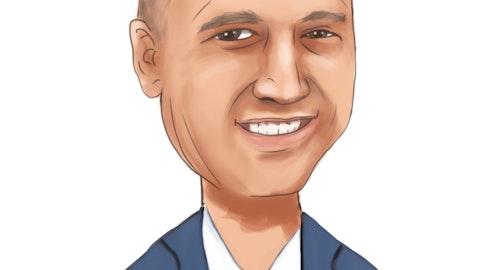Old Second Bancorp, Inc. (NASDAQ:OSBC) Q3 2023 Earnings Call Transcript October 20, 2023
Operator: Good morning, everyone, and thank you for joining us today for Old Second Bancorp Incorporated Third Quarter 2023 Earnings Call. On the call today are Jim Eccher, the company’s Chairman, President and Chief Executive Officer; Brad Adams, the company’s Chief Operating Officer and Chief Financial Officer; and Gary Collins, the Vice Chairman of our Board. I will start with a reminder that Old Second’s comments today will contain forward-looking statements about the company’s business, strategies and prospects, which are based on management’s existing expectations in the current economic environment. These statements are not a guarantee of future performance and results may differ materially from those projected.
Management would ask you to refer to the company’s SEC filings for a full discussion of the company’s risk factors. The company does not undertake any duty to update such forward-looking statements. On today’s call, we will be discussing certain non-GAAP financial measures. These non-GAAP measures are described and reconciled to their GAAP counterparts in our earnings release, which is available on our website at oldsecond.com on the homepage and under the Investor Relations tab. Now I will turn it over to Mr. Jim Eccher.

A customer meeting with a loan officer in a bank office, discussing their financial goals. Editorial photo for a financial news article. 8k. –ar 16:9
James Eccher: Good morning, and thank you for joining us today. As customary, I have several prepared opening remarks, we’ll give my overview of the quarter, then I’ll turn it over to Brad for additional details. I will then conclude with certain summary comments and thoughts about the future before we open it up to Q&A. Net income was $24.3 million or $0.54 per diluted share in the third quarter. Adjusted net income was $24.8 million or $0.55 per diluted share in the third quarter. On the same adjusted basis, return on assets was 1.70% and third quarter 2023 return on average tangible common equity was 22.80% and the tax equivalent efficiency ratio was 50.08%. Third quarter earnings were negatively impacted by $924,000 in pretax securities losses on strategic security sales as well as $629,000 in net deconversion and liquidation costs related to the Visa credit card portfolio sale last year.
The combined impact of these 2 items reduced diluted earnings per share by $0.03 in the third quarter. Our financials continue to be favorably impacted by elevated market interest rates with a $7.5 million or 13.4% increase in net interest income in the third quarter compared to the prior year late quarter due to manageable funding cost increases along with significant expansion in asset yields across the balance sheet. The third quarter of 2023 reflected loan growth of $14 million for the linked period and expanded $160.2 million or 4.1% over the same period last year. Loan prepayments continue to be modest. However, origination activity has slowed significantly over the last 6 months. Activity within loan committee remains modest relative to prior periods due both to higher interest rates and seasonal impacts.
The net interest margin expanded slightly this quarter, driven by increased loan yields, partially offset by the higher cost of deposits. Loan yields continued to expand modestly during the quarter increasing by 9 basis points over the linked quarter and 127 basis points year-over-year. The tax equivalent net interest margin was 4.66% for the third quarter compared to 3.96% in the third quarter of last year. The margin has benefited year-over-year from balance sheet mix improvement, the impact of rising rates on the variable portion of the loan portfolio and continuing loan growth in 2023. The loan-to-deposit ratio is now 87% as of September 30 compared to 85% last quarter and 73% as of September 30, 2022. As we said last quarter, our focus continues to be balance sheet optimization, and I’ll let Brad talk about that in a minute.
We had previously expected to report a linked quarter improvement in credit metrics with workout plans in place for a few credits we had downgraded in prior quarters. Unfortunately, these plans designed to improve cash flow metrics fail to materialize this quarter. Our outlook has not changed, though, although the speed of resolution will be slower than hoped. The good news is the portfolio trends remain well behaved on an overall basis and the stress testing at renewal rates has not raised any new red flags for us. On an overall basis, nonaccruals were largely unchanged with some pluses and minuses under the covers. Classified loans did tick up a bit this quarter, due largely to 3 credits. First is a $17 million multifamily mixed-use project that is characterized at this point is half complete and leased and half unimproved, sponsors are looking to liquidate the property.
We don’t expect significant losses here, if any. The other credits are health care related, and while nicely occupied at below par debt service coverage ratios due to the combination of higher renewal rates and significantly higher labor cost inputs. Beyond these impacts are ongoing evaluations of commercial real estate and office have not revealed significant deterioration at this point. And the trends within criticize assets are stable. Clearly our focus remains on monitoring potential weakness in commercial real estate and office and health care specifically. We have stressed on maturing credits under renewal rates and believe we don’t see broad-based risk. We’ve been very proactive on refreshing valuations. And as a result, our outlook for credit has not changed.
I think it’s important to remember that nearly half of our commercial real estate exposure is owner-occupied, which we believe is unusual for a bank of our size. And our office exposure is only about 5% of the loan book. We simply don’t have much exposure here, and we are watching it very closely. Please refer to the additional disclosures in our earnings release for more color on the portfolio. We recorded net charge-offs of $6.6 million in the third quarter of 2023 compared to $505,000 of net charge-offs in the second quarter. The majority of the current period charge-offs were specific to 2 borrowers within commercial real estate on which we had existing specific allocations within the ACL of $4.7 million at June 30. Other real estate owned reflected a $354,000 decrease in the third quarter to end at $407,000 in total based on 4 property sales during the quarter, net of one transfer into OREO.
The allowance for credit losses on loans decreased to $51.7 million as of September 30 from $55.3 million at the end of the previous quarter, which is 1.3% of total loans as of September 30, 2023, down from 1.4% total ACL to gross loans as of June 30. Unemployment and GDP forecast used in future loss rate assumptions remained fairly static from last quarter. I think investors should know that we remain confident in the strength of our portfolios and the credits driving the reduction in the allowance of the same credits we’ve talked about previously and which we continue to monitor and work towards remediation or sale. Noninterest income continued to perform well, and excluding losses on security sales discussed earlier, noninterest income increased $1 million compared to the second quarter of 2023 driven by gains on BOLI income due to restructuring, MSR gains and other income.
Pretax losses of $924,000 on security sales in the third quarter were incurred related to strategic repositioning within certain types in the portfolio. Expense discipline continues to be strong and our efficiency ratio continues to be excellent. As we look forward, we’re focused on doing more of the same, which is managing liquidity and building commercial loan origination capability for the long term. The goal is obviously to continue to build towards a more stable long-term balance sheet mix featuring more loans and less securities in order to maintain the returns on equity commensurate with our recent performance. I’ll turn it over to Brad now for more color in his comments.
Bradley Adams: Thank you, Jim. Net interest income decreased slightly to $63 million for the quarter relative to the prior quarter of $63.6 million, but increased $7.5 million or 13.4% from the year ago quarter. Loan yields continued to grow in the third quarter, though at a slower pace than recent periods, and securities yields declined slightly since last quarter due to the significant sales of variable rate issues this quarter and last. Total yield on interest-earning assets increased 10 basis points to 549 basis points and was partially mitigated by a 25 basis point increase in the cost of interest-bearing deposits and a 14 basis point increase to interest-bearing liabilities in aggregate. The end result was a 2 basis point increase in the taxable equivalent NIM from last quarter to 466, which we believe continues to be exceptional margin performance.
As discussed in last quarter’s call, we redeemed the outstanding senior debt issuance on June 30. This redemption provided a net interest margin cost savings of approximately 3 basis points net of alternative funding costs. Deposit flow this quarter showed modest leakage on the high end, along with typical seasonal decline in the third quarter, we always see based on tax payments for personal and business customers and commercial customers rolling out new activities throughout the summer. The nature and character of the decline largely looks like an inverse move of the flows into the bank, we saw beginning in the latter half of 2020 through 2021. Fortunately, we have the liquidity and the balance sheet flexibility to adapt and will continue to remix and optimize rather than chase high beta deposits.
We still aren’t lurching at anything, but have made some fairly significant progress in reducing asset sensitivity over the last year, including reducing variable rate securities concentrations. Variable rate issues within the bond portfolio are now approximately 18%, a level that is roughly half where it was before rates started moving higher. There has been some significant income and margin give-up associated with doing this, but it’s the right time to return to a normal duration profile within the portfolio. As the belief in higher for longer has taken hold, spreads have tightened considerably on some of the variable rate issues we hold. Duration is slowly being added to reduce asset sensitivity and numerous other ways as well. I still don’t see much opportunity to hedge away asset sensitivity, but balance sheet positioning and flexibility at this point is excellent, in my opinion.
Effective duration on the bond portfolio is now 2.7 years. Rates during the quarter moved much more significantly further out the curve. So Old Second saw significantly less fair value deterioration than perhaps some peers experienced. The loan-to-deposit ratio remains low, and our ability to source liquidity from the portfolio has increased relative to the color we gave you last quarter. The bid has come back a bit on variable rate issues, as I said, and that has allowed us to move out of our excess positioning here quite effectively. The mark on the securities portfolio remains high but will be recaptured relatively quickly. The net result is that Old Second should continue to build capital very quickly as evidenced by the 50 basis point improvement in the TCE ratio over the linked quarter, even without a tailwind from AOCI, which combined with the 93 basis points in the first 6 months means we’ve added 143 basis points of TCE this year.
As we sit here today, we have approximately $700 million in undrawn borrowing capacity and an additional $420 million in unpledged securities and short liquidity at the bank is excellent, and the holding company is in a strong position as well. We are likely to seek non-objection to resume stock repurchases soon. Margin trends from here are expected to be relatively stable over the remainder of the year with benefits from the last rate hike still to come and continued asset repricing not expected to outpace the increased reliance on our overnight borrowings by very much. Provision for credit losses of $3 million was recorded during the quarter and was primarily attributable to credit losses on loans. Net of an immaterial reversal of provision on unfunded commitments during the quarter.
I would expect loan growth to be roughly consistent with provision growth over the near term, though that could change with significant worsening in the macro environment. Noninterest expense increased $2.6 million from the previous quarter, driven by higher salaries and employee benefits as well as expenses related to liquidation and deconversion fees from the Visa credit card portfolio. I continue to expect quarterly wages and benefits to be between $22 million and $23 million going forward in the near term. Given the revenue performance, employee investment costs have been running high, but we will maintain the ability to dial back as conditions warrant. I would be remiss if I didn’t add that we are not really in the market to chase much growth here.
Doesn’t really make sense given the marginal yields available relative to the marginal cost of funding and the cost associated with origination. As such, we remain focused on optimization and efficiency. I believe our results indicate that we are doing a pretty darn good job at this so far. It can continue, and I believe we can potentially grow earnings absent balance sheet growth. At the very least, I believe earnings can be much more resilient than perhaps many people expect from us. With that, I’d like to turn the call back to Jim.
James Eccher: Okay. Thanks, Brad. In closing, we remain confident in our balance sheet and the opportunities that are ahead for us. We’re paying close attention to both credit and expenses. We believe our underwriting has remained disciplined, and our funding position is strong. We have the balance sheet and flexibility to excel at a higher rate environment. Capital levels should continue to grow and maintain levels above targets, and we will look to be aggressive in adding talent and relationships. That concludes our prepared comments this morning. So I’ll turn it over to the moderator to open it up for questions.
See also 20 States With Most Expensive Electricity In The US and 20 Countries With The Highest Chicken Consumption.
Q&A Session
Follow Old Second Bancorp Inc (NASDAQ:OSBC)
Follow Old Second Bancorp Inc (NASDAQ:OSBC)
Operator: Thank you. At this time, we will be conducting a question-and-answer session. [Operator Instructions] Thank you. Our first question is coming from Jeff Rulis with D.A. Davidson. Your line is live.
Jeff Rulis: Thanks. Good morning.
James Eccher: Good morning, Jeff.
Jeff Rulis: Jim, I appreciate the comments on the credit side. I kind of want to just check in on the balance of nonaccruals. Are there some – maybe I think you mentioned the time line to resolution maybe extended a bit, but trying to get a sense for that balance of nonaccruals. Are there some chunkier credits in there that may have kind of a shorter time line to resolution? I’m trying to dig into a little bit of pace of resolution from your perspective.
James Eccher: Yes, there are chunkier ones, Jeff. And I will tell you, it’s primarily concentrated in CRE office and health care. What’s made some of this challenging is that there are shared credits so that their participation is purchased. And we’re working closely with the lead bank to write a resolution. We do feel we will have resolution on a couple of these. It’s just taking a little bit longer. There’s a couple of properties under contract. We’re looking at no sale options. But it seems as though the time to resolve credits has just taken longer than what it used to.
Jeff Rulis: Got it. And within the charge-offs looks like mostly in the CRE bucket, were those from credits that were kind of new to classifieds or just something that’s existing…
James Eccher: Those are two office buildings that we had already allocated for prior quarters and we took the charges to position them for either sale or no sale.
Bradley Adams: These are the same credits we’ve been talking about in the last 2 calls, Jeff.
Jeff Rulis: Yes. Just making sure that I didn’t know where to – I appreciate that detail. And I guess those increase in classifieds sounded like a multifamily mixed-use and then to health care related. I guess the first of which, I think you said not a lot of losses expected there and perhaps liquidation occurring soon. On the health care front, are these – what any more detail on those 2 credits?
James Eccher: Sure. Sure. I’ll give you some color. The largest net addition to classified were from health care construction and owner-occupied commercial real estate. I would say the construction in the owner-occupied commercial real estate credits are isolated issues pretty well collateralized. The owner-occupied one is SBA backed 55% loan to value or we don’t see a loss there, obviously. And then the construction-related project is backed by some sponsors that have just decided to abort the project. It’s a mixed-use multifamily retail. We – there’s substantial equity behind us on this. Again, we think these properties are in the process of being sold. It’s just taking a little bit longer. The two health care credits, both are just struggling from a cash flow perspective as they’re dealing with the aftermaths of COVID, higher labor cost and just weaker occupancy.
Surprisingly, we’ve got refreshed appraisals for loan to values in both of those properties, and we’re talking about appraisals within the last few months, are still hanging in there, one at sub-50% and one about 65%. So there’s going to be longer-term workouts and really probably going to be a situation where we’re going to have to go back to the sponsors and ask for more equity to rightsize the transactions. That answer your questions, Jeff?
Jeff Rulis: Yes. No, that’s – Jim, appreciate the color. I mean I – trying to true that up with kind of your thoughts on overall credit. It sounds like while kind of frustrated by the pace in some of these. But the positioning and loss content, you feel pretty good about. So I appreciate the color. Maybe just one other question on the – just on security sales. Do you think you’ve got similar positioning to do there? Or you’re happy with what happened this quarter and that could be pretty quiet going forward?
Bradley Adams: Yes, we’re going to keep selling. We peaked out at around 35% of the portfolio when rates were 0 being variable just to make sure we were protected in a higher rate world. As we’ve kind of started to slow down on the movement in rates, we have been moving out of that, as we’ve told you about. We’re down to 18% now, a good long-term rate stability type level is probably like 10%. As you know, we don’t have a lot of duration on the asset side of the balance sheet. So typically, a securities portfolio does serve as both a warehouse for liquidity and duration for us, but we couldn’t do that given the kind of asymmetric risk that existed when rates were zero. So we did this. And now we are moving out of it, and we – you should expect us to continue to move out of it.
A couple of things. I mean, one, we would probably have a margin above five right now if we just stood pat and hadn’t done this, and our earnings susbtantially higher. But – we will always be asset sensitive just given what we are, which is the strength of the deposit base, but we can be less so. And that’s what we’re progressing towards, and we’re doing it in such a manner that doesn’t involve paying transaction fees and broker fees and having to fair value various hedge accounting issues. This is the most cost-effective way to step out of it. And I’m grateful that everybody has decided they want to be in variable rate issues over the last 4 months because it has tightened up our execution a great deal.
Jeff Rulis: Okay. Well, appreciate it, Brad. It sounds as if a lot of the legwork has been done and it looks like you got, I guess, if you go 18% to 10%, you get a little bit more. But the securities losses have been narrowing as well. Would that be the expectation as you wind it down, that would become less of a drag on the income statement?





